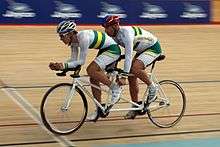Para-cycling
Para-cycling (or Paracycling) is the sport of cycling adapted for cyclists who have various disabilities. It is governed by the Union Cycliste Internationale (UCI). The sport consists of seven different events which include road and track races. The world's elite para-cyclists compete at Worlds Championships, the Paralympic Games and the World Cup.[1]
History
Para-cycling originated in the 1980s, starting visually impaired riders who competed on a tandem with a sighted partner. It entered the Summer Paralympic Games in 1984, where it consisted of only road races for riders with cerebral palsy. By 1996 track cycling was included and a variety of disabilities in various functional categories. Handcycling was included in the 2000 Paralympics in Sydney Australia as an exhibition event.[2]
Events

Para-cycling events consist of the following three road races and four track events:[1]
Road
- Road race (men and women)
- Individual time trial (men and women)
- Handcycling relay
Track
- Tandem sprint (men)
- Team sprint (men and women, mixed event)
- 500 m or 1000 m time trial (men and women)
- Individual pursuit (men and women)
Classification
Classification of riders consists of four broad groups; visual impairment, cerebral palsy, mobility impairment and handcycling. These are subdivided into 14 functional categories for men and women. Riders are placed in the appropriate category according to their functional ability.[1]
References
- 1 2 3 "Para-cycling - About". Uci.ch. Retrieved 2015-08-10.
- ↑ "Cycling Ireland | Paracycling". Cyclingireland.ie. Retrieved 2015-08-10.